We have created a comprehensive “Beginner’s Guide to Setting Up a Google Ads Account” to assist those new to PPC advertising. Google Ads is often the recommended platform for beginners. The guide provides step-by-step instructions for account setup, including campaign structures, settings, payment options, and tracking. Additionally, it offers valuable insights on keyword research, creative tips, and tricks to optimize your campaigns.
Are you ready to launch successful campaigns?
As highlighted earlier, there are several crucial factors to consider for achieving success on the Google Ads platform. Take a moment to review the checklist below to ensure you have addressed these important elements:
- User-friendly website: Make sure your website is designed in a way that guides visitors towards your desired conversions.
- Clear PPC strategy and goals: Define your PPC strategy and set specific goals. For guidance in this area, you can refer to the helpful resource “How should you formulate your PPC Strategy” by Diane Anselmo.
- Allocate a budget and timeline: Determine a budget and timeline for your testing phase. We recommend setting aside a minimum of $500 per month for a duration of 3 months.
By addressing these key elements, you’ll be well-prepared to launch successful campaigns on Google Ads.
Essential Steps for Account Set Up
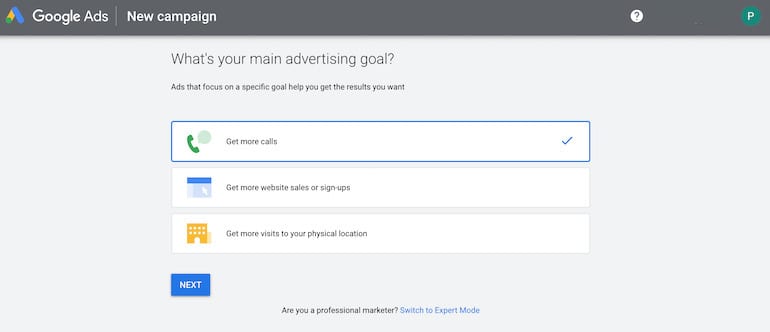
After reaching that point, you will receive a prompt to create a campaign. While it is possible to proceed with campaign creation, I suggest skipping this step until you become more acquainted with the interface.
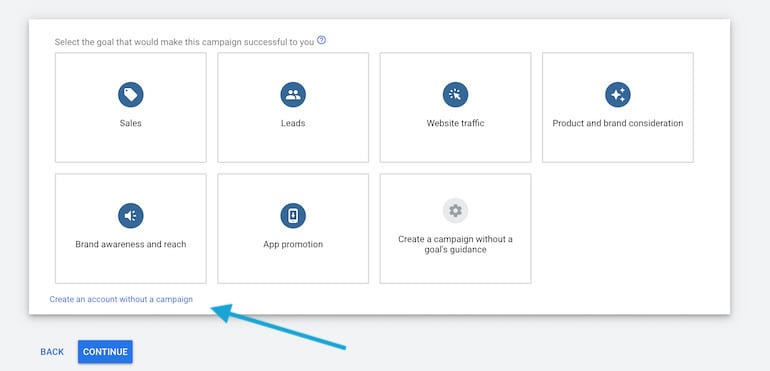
Following that, you will be prompted to verify your business information. It is crucial to ensure the accuracy of this information as it cannot be modified in the future.
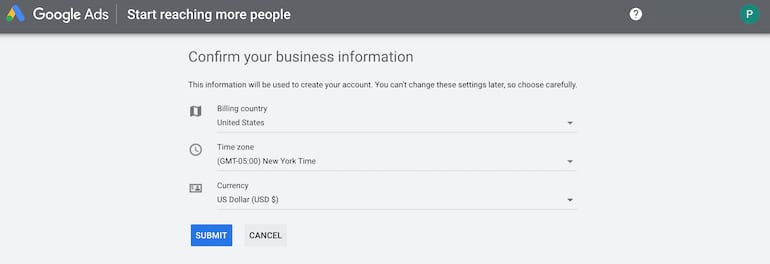
After reaching that point, you can begin exploring your newly created account!
However, it’s important to note that the previous interface provided some essential elements to consider, including:
- Selecting your budget
- Creating compelling ads
- Choosing relevant keywords to target potential customers
- Providing your billing information
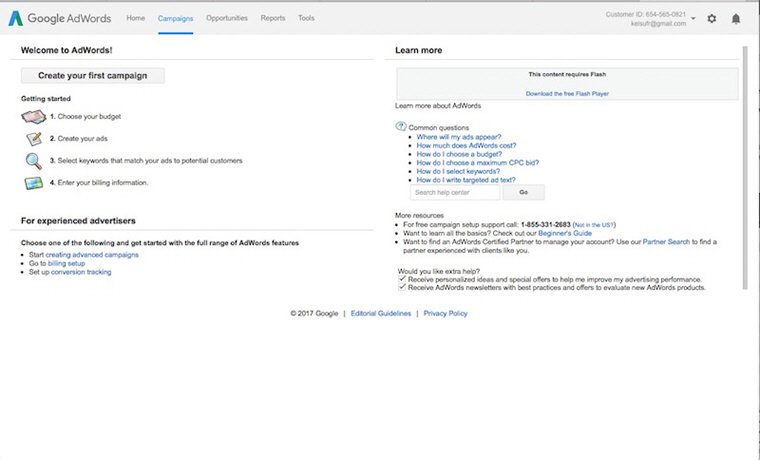
However, with the new user interface, you will be directed straight to the main account page. Although you still need to complete all of the aforementioned tasks, they may not be prompted in the same format as before. Therefore, it’s important to proactively navigate to the relevant sections and complete the necessary steps for setting up your budget, creating ads, selecting keywords, and entering your billing information
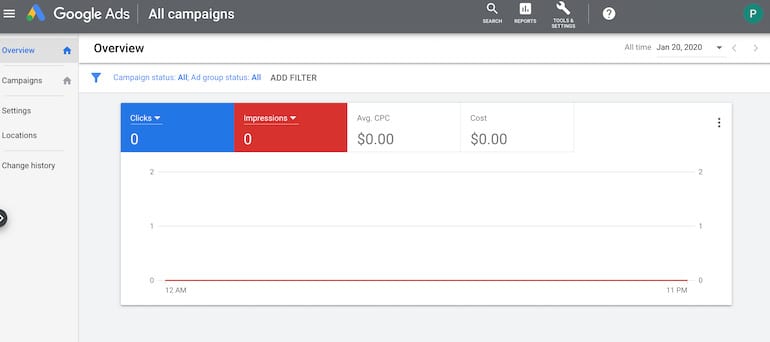
Before diving into creating your first campaign, it’s important to do some upfront work to avoid having to backtrack in the setup process. The initial focus should be on keyword selection and account structure. By addressing these areas first, you can lay a solid foundation for your campaigns and streamline the setup process.
Creating An Initial PPC Keyword List
Keyword research is the foundation of a pay-per-click campaign.
Beginner’s tip: Keywords are the specific words or phrases that your potential customers use when searching for your product or service. By bidding on these keywords, your ad can appear when customers search using those keywords.
There are several important areas to consider when building your keyword portfolio:
- Company website: Review your website to identify core words and phrases that accurately describe your business. This will help shape the structure of your campaigns and provide a starting point for keyword selection.
- Keyword research tools: Utilize keyword research tools to expand your keyword list beyond the core terms from your website. These tools provide valuable insights into search volume, competition, and suggested bids. They can also help you discover keyword variations and synonyms. There are various tools available for research, and you can find a comprehensive list in our PPC Hero post, “You’re bidding on all the wrong keywords” by Jacob Baadsgaard.
- Think like your customer: Put yourself in your customers’ shoes and consider what they would search for when looking for your product or service. Think about the problems they are trying to solve, and identify keywords that align with their search intent.
- Don’t overlook brand terms: It’s important to include your brand terms in your keyword strategy. Showing up in both paid and organic results for branded keywords can provide additional visibility and reinforce your brand presence.
By considering these areas, you can build a comprehensive and effective keyword portfolio for your Google Ads campaigns.
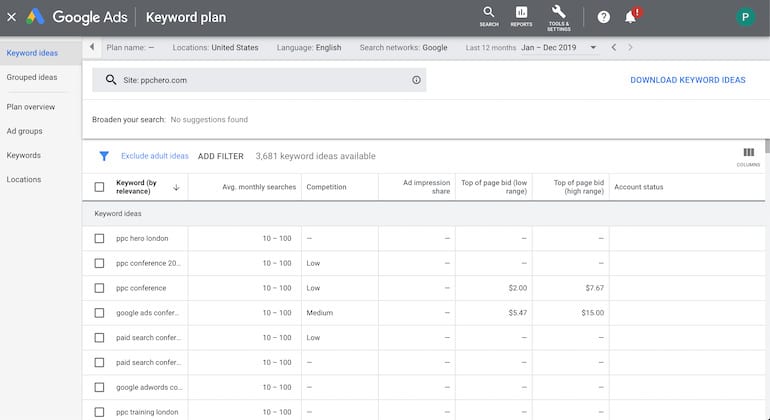
Keyword research is a continuous process, but having a solid list of initial keywords is crucial to achieving success in PPC advertising.
Building a Solid Campaign Structure: Essential Tips for Success
Organize for Success: Tips and Best Practices for Campaign Structure
The organization of your campaigns plays a crucial role in determining the success of your Google Ads account. A well-structured account can positively impact your quality score and overall performance. Here are some essential tips and best practices for creating a solid campaign structure:
- Segment by Relevant Themes: Divide your campaigns into logical segments based on higher-level ideas. This could be based on the products or services you offer, geographical location, performance and bidding, brand names vs. generic names, seasonality, or keyword match types. This segmentation allows for more targeted ad groups and keywords within each campaign.
- Maintain Relevance: Ensure that your ad groups are closely related to the campaigns they belong to. Avoid mixing unrelated products or services within the same campaign, as it can hinder performance tracking and compromise ad copy and landing page relevance.
Example:
Campaign: shoe_Brands
- Ad Group: shoes_nike
- Ad Group: shoes_adidas
Campaign: shoe_Types
- Ad Group: shoe_athletic
- Ad Group: shoe_boots
- Ad Group: shoe_sandals
- Align Ad and Landing Page Experience: Your ad groups dictate the ad and landing page experience delivered to searchers. Aim to create a structure where campaigns, ad groups, keywords, and ads are all relevant to each other. This alignment enhances the user experience and boosts the chances of conversions.
Remember, a well-organized campaign structure sets the foundation for effective ad delivery, performance tracking, and optimization. By implementing these tips, you can optimize your campaigns for success.
Ad Creation & Landing Page Mapping
One important aspect of campaign creation is crafting effective ads and mapping landing pages for each ad group. The success of your keyword portfolio and campaign structure relies heavily on the ad and landing page experience. Relevant ads and landing pages not only drive click-through rates, cost per lead, and ROI, but they also impact your Quality Score.
Google assigns a keyword-level Quality Score to each of your keywords, with click-through rate being a significant factor in the calculation. A higher Quality Score can lead to better ad positions and lower cost per clicks, allowing you to maximize your budget.
Before writing your ads, consider your target audience and how you want to appeal to them. Take into account your brand, products or services, and the desired action you want your audience to take on the landing page.
Here are some tips for writing effective ad text:
- Brand: Maintain consistency with other marketing efforts and align your ad text with your brand message.
- Products/Services: Highlight the specific product or service you offer and emphasize any unique advantages or features.
- Goal: Clearly outline the desired action you want your audience to take, such as making a purchase, signing up, or learning more.
By carefully crafting your ad text, you can increase the likelihood of attracting relevant clicks and achieving your campaign goals. Remember to continually monitor and optimize your ads to improve performance over time.
Expanded Text Ad
You have a total of 300 characters available in your ad to entice users to click. This includes three headlines, two descriptions, and the URL path.
Character Limits
- Headline 1: 30
- Headline 2: 30
- Headline 3: 30
- Description 1: 90
- Description 2: 90
- Path 1: 15
- Path 2: 15
Beginner Tip: Utilize the Excel LEN function to count the number of characters in each line of your ad copy.
Ad Extensions
In addition to the ad itself, ad extensions offer advertisers the opportunity to enhance their ads and provide additional information to potential customers. There are various types of ad extensions available, including:
- Sitelink Extensions: Direct customers to specific pages on your website.
- Callout Extensions: Highlight key benefits or features of your products or services.
- Location Extensions: Encourage customers to visit your physical store or business location.
- Call Extensions: Allow customers to directly call your business from the ad.
- Price Extensions: Display the prices of your products or services.
- Promotion Extensions: Showcase special promotions or offers available on your website.
These ad extensions can help increase the visibility and effectiveness of your ads by providing more relevant information to users. Be sure to explore the full list of available extensions on the Google Ads Support site to find the ones that best suit your advertising goals.
Landing Page Mapping
When crafting your ads, aim to provide a seamless path to conversion for your customers. If a customer is searching for Gucci Handbags, it’s important to direct them to a specific page on your website that showcases the Gucci bags you offer. Nowadays, customers have limited patience and prefer to find their desired outcome with just one click.
With the preparation work done, you’re now ready to dive into the interface and set up your first campaign. Ensure that you have your keywords organized into campaigns and ad groups. Each ad group should have multiple ad variations prepared and aligned with relevant landing pages. This will help maximize the effectiveness of your ads and drive conversions
Campaign Setup and Configuration
Once you have logged into ads.google.com, you can start creating your campaign by following these steps:
- Click on “Campaign” on the left-hand side of the page and then select “+New Campaign.”
- On the next page, you will be prompted to choose your campaign goal. You can either select a specific goal or choose “Create a campaign without a goal’s guidance.”
- Next, you will need to configure several settings for your campaign:
- Type: The Google network offers various campaign options, such as Search Network with Display Select, Search Network Only, Display Network Only, Shopping, Video, and Universal App Campaign. For testing purposes, the most common setting would be “Search Network Only.”
- Network: You can choose from three network options: Google Search Network, Google Search Network including search partners, and Google Display Network. In the testing phase, “Search Network Only” is often the preferred choice. However, depending on your budget and desired impressions, you may consider including search partners, although the traffic may be less qualified.
- Devices: By default, ads are set to show on all devices. If you want to exclude certain devices, you can use bid modifiers. For more information on this topic, you can refer to our PPC Hero blog post by Stephanie White titled “Why You Need to Apply Negative Bid Modifiers.”
- Locations/Languages: In this setting, you can choose the geographic region where you want your ads to appear. If you have a local business, you can select specific cities, regions, or use radius targeting. Additionally, you can select the appropriate language for your target audience.
By carefully configuring these settings, you can ensure that your campaign is optimized for your specific goals and target audience.
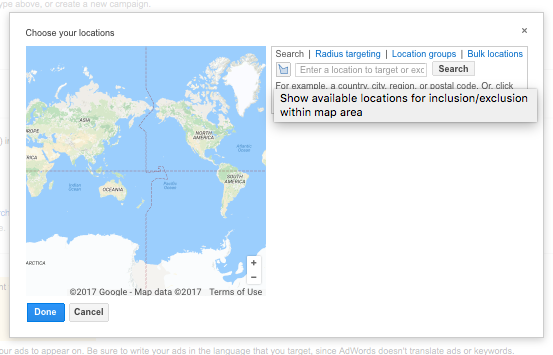
Bid Strategy – The choice of bid strategy is crucial for your campaign. It is essential to carefully consider your daily budget allocation to avoid overspending. Setting the budget too high could exhaust your monthly budget quickly. It is recommended to start with a realistic budget for each campaign and adjust it based on actual spend levels as you gather insights and learn from the campaign’s performance. By closely monitoring and optimizing your bid strategy, you can ensure efficient spending and maximize the results of your campaign.
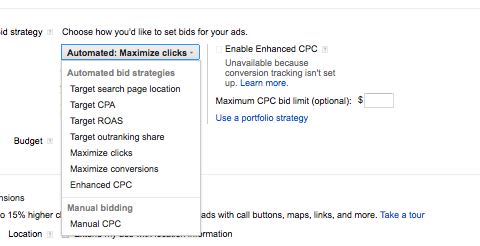
Bid Strategy – In this setting, you have the option to choose a bid strategy that aligns with your campaign goals. Google Ads provides detailed explanations of various automated bid strategies that can enhance performance on their support site. As a general recommendation, it is advisable to start with manual bidding and set a cost per click (CPC) that you are comfortable with for each campaign. Manual bidding allows you to have more control over your bids and budget. Once you gain more experience and data, you can explore and experiment with automated bid strategies to optimize your campaign performance further.
Finalizing Your New Google Ads Account
When you choose the “create new campaign” feature in Google Ads, you will go through four steps to set up your account. Since you have already completed your research and prepared all the necessary settings, this process will be relatively straightforward.
Step One: Campaign Creation and Settings – ✔️ Completed
Step Two: Ad Group & Keyword Creation – ✔️
Completed Step Three: Create your first Ad – ✔️
Completed Step Four: Finish and Save – ✔️ Completed
Once you have completed the previous steps of campaign creation and settings, ad group and keyword creation, creating your first ad, and finishing and saving the campaign, the next step is to add your billing information. This is an essential step to ensure that your ads can start running.
Review Advanced Settings After Set Up
After completing the account setup and implementing basic campaign settings, you can explore the advanced campaign settings. During the setup phase, you may want to consider modifying your ad delivery option. We recommend initially setting your ads to rotate evenly. This approach provides more control over ad copy tests and allows your campaign to gather data before relying on machine learning algorithms.

Tracking Considerations
Conversion tracking in Google Ads is a free and powerful tool that enables you to utilize smart features like smart bidding and optimize your campaigns for conversions. It allows you to track various metrics, including:
- Website actions
- Phone calls
- App installs and in-app actions
- Import from offline conversion metrics
To start tracking conversions, you need to implement the Google Ads conversion tracking tag into your website’s code. Detailed instructions for implementation can be found on the Google Ads support site.
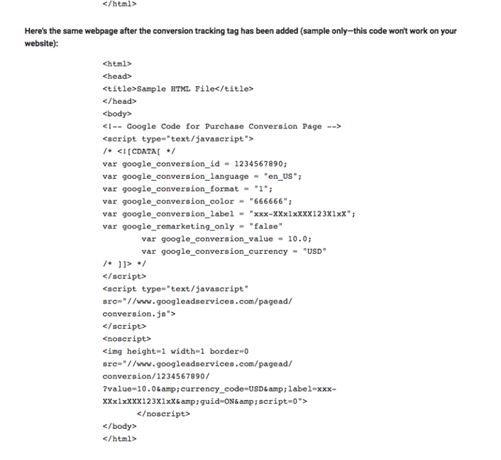
Linking your Google Analytics account with Google Ads is a highly recommended tracking option. By linking the accounts, you can gain valuable insights and access additional data to enhance your advertising campaigns. Detailed instructions on how to link your accounts can be found in the help section of the Google Analytics site.
A Word For Success
The above steps cover the basics of launching a Google Ads account. However, the work doesn’t end there. It’s crucial to regularly review your account’s performance, optimize your campaigns, and make data-driven adjustments. One common misconception about pay-per-click advertising is that you can simply set it up and forget about it. To achieve the best results, ongoing monitoring and optimization are necessary.
